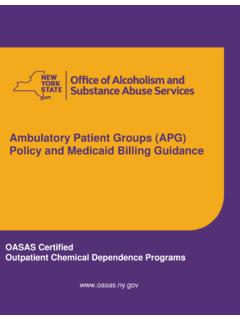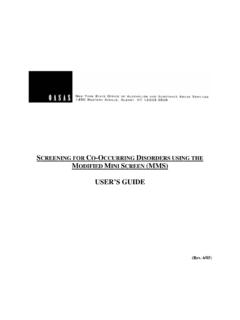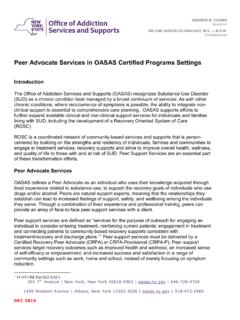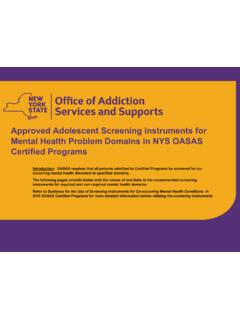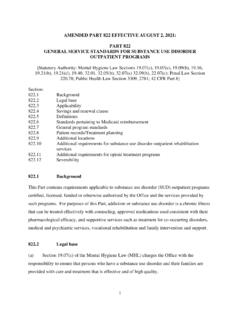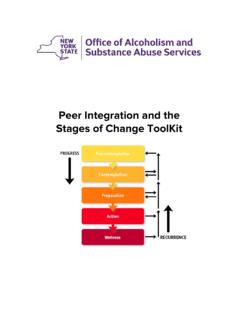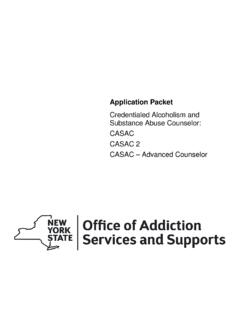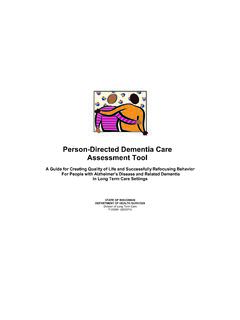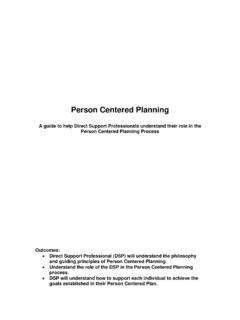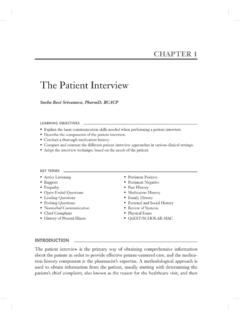Transcription of A New York State Office of Alcoholism and Substance Abuse ...
1 A New York State Office of Alcoholism and Substance Abuse Services Approved Tool Contents BACKGROUND AND CONTEXT .. 2 LOCADTR Guidance .. 4 LOCADTR Content .. 7 LOCADTR LOGIC and QxQ .. 9 QxQ: PRELIMINARY CLIENT INFORMATION .. 12 QxQ: PRELIMINARY ASSESSMENT .. 14 QXQ: CRISIS/DETOX ASSESSMENT .. 21 QxQ: RISK ASSESSMENT .. 28 QxQ: RESOURCE ASSESSMENT .. 39 QxQ: OVERRIDE OPTIONS AND ALTERNATIVE LEVEL OF CARE .. 46 ADDITIONAL CONSIDERATIONS .. 48 Appendix A LOCADTR Consent .. 49 Appendix B Access LOCADTR via the Health Commerce System: A Three Step Process .. 50 Appendix C Level of Care Definitions .. 51 Appendix D - ASAM Crosswalk with OASAS Levels of Care .. 56 Appendix E - Alternative Levels of Care .. 57 Appendix F LOCADTR Bibliography .. 58 1 Welcome The New York State Office of Alcoholism and Substance Abuse Services (OASAS), in partnership with The National Center on Addiction and Substance Abuse (CASAC olumbia), has designed, built, and tested a web-based tool that will aid Substance Abuse treatment providers in determining the best level of care for a client with a Substance use disorder.
2 This tool is named the LOCADTR, which stands for Level of Care for Alcohol and Drug Treatment Referral. This manual will explain the reasoning behind the LOCADTR, and the logic of the tool, which includes a step-by-step guide through the questions, and answers to Frequently Asked Questions. Overview of the LOCADTR Designed for Substance Abuse treatment providers and referral sources working with individuals who experience Substance use disorders, the LOCADTR guides decision making regarding the appropriate level of care for a client. The LOCADTR is meant to ensure that all individuals in need of treatment for a Substance use disorder have access to care and are placed in the setting closest to the client s community that provides a safe and effective setting for treatment.
3 , In addition to helping providers and clients, the data collected through the LOCADTR will be analyzed to assess provider and system level performance, inform needs assessments, and i nform the relationship between Level of Care determinations and client outcomes. All personal health information collected will be protected and never re-disclosed. Level of care is determined by a variety of factors, including: o Assessment of the clients need for crisis or detoxification services (for instance, determining possible medical complications from withdrawal); o Risk factors (such as the presence of severe medical and psychiatric conditions); and, o Resources available to the client (for example, a social or family network who are supportive of recovery goals) 2 BACKGROUND AND CONTEXT Introduction All persons who work with individuals that have a Substance Use Disorder (SUD) have an interest in identifying the most appropriate level of care for that client.
4 Concerned parties include, but are not limited to: family members, significant others, physical health and mental health providers, managed care plans, criminal justice entities, local social service districts, and other referral agencies. OASAS believes that all stakeholders would benefit from a common, standardized tool that would assist in making a level of care decision that takes into account client- centered care, recovery principles, and the client s risks and resources. OASAS also recognizes the value in using a common assessment tool across all regions and entities so that all decision making is based on the best clinical evidence for level of care available. The goal should always be to provide care at the right time, in the right setting, and for the right duration and intensity.
5 To address these goals, a process was undertaken to ensure that such a tool is available to all NYS Substance Abuse treatment providers and referring entities. Process of Developing the Web-Based LOCADTR Tool The Office of Alcoholism and Substance Abuse Services (OASAS) convened a Clinical Advisory Panel in 2012. The purpose of this panel was to provide recommendations for implementing a standard level of care tool prior to the implementation of the Medicaid managed care for behavioral health services. The Panel acknowledged that accessing the most clinically appropriate level of care in Substance use disorder (SUD) services was essential in providing safe and effective SUD treatment. The Panel also recognized that it was crucial to identify one tool that utilized a client- centered approach to assessing level of care need to ensure the use of consistent standards across the State .
6 The Panel explored all level of care assessment tools that were available at the time. After examination of these tools, the Panel determined that OASAS should revise the LOCADTR to include two things: 1) New York specific levels of care; and, 2) The New York State recovery vision that was based on both risk of harm from Substance use AND individual resources that support recovery goals in the community. 3 As a result, a workgroup was formed to create a tool that met the following goals: User-friendly: The ability to be completed in minutes using a modern, intuitive web-based platform; Patient- centered : Based on an individualized clinical assessment; Recovery-oriented: Inclusion of recovery concepts and encourage the use of community and family supports; Least restrictive: Logic supports the principle of treating as close to the individual s community as is clinically appropriate; Relevance: Include Levels of Care known and understood in New York; Reliability: Predictably and accurately recommends the best level of care.
7 Credibility: Managed care plans and SUD treatment providers accept the tool and agree that there is evidence to support the tool; Clinical Support: Provides information to clinicians to support the level of care decisions which are understood by payers and auditors. Once the workgroup identified the logic structure of the tool, including the topics to be covered and how they would interact with one another, OASAS approached CASAC olumbia as a partner in the development of the tool. CASAC olumbia would assist to further develop the tool, develop a plan for testing, and translate the tool into an electronic format. The Clinical Advisory Panel, OASAS, and CASAC olumbia documented the overall concepts and intentions of the workgroup and then developed the questions that would comprise the LOCADTR tool.
8 CASA Columbia applied techniques in the question development to enhance the psychometric characteristics, such as reliability and validity. The Clinical Advisory Panel, OASAS, and CASAC olumbia worked with NYS Information and Technology Services, as well as Flightpath, a technology vendor, to develop a user- friendly web-based tool. This tool is LOCADTR The tool has been tested for usability and clinical face validity. 4 LOCADTR Guidance_____ LOCADTR is a clinical tool, used in conjunction with a full assessment of an individual presenting for Substance Use Disorder treatment. The purpose of the LOCADTR is to determine the most appropriate recommended level of care based on the clinician s answers to the individual s risks and resources. No tool can replace clinical judgment and there is an option within the tool to override the recommended level of care based on clinical judgment.
9 Who can use the LOCADTR? The LOCADTR requires the clinical staff person to complete an assessment of an individual s presenting issues, history, medical, mental health, risk and resource information, and to make clinically informed decisions in order to answer the questions. Staff who are working in an SUD setting with appropriate supervision within the scope of their practice can use the LOCADTR to make level of care recommendations. Medical staff is required to complete the crisis decision tree where there is a potential for serious or life threatening withdrawal to occur. The recommendation for clinical detoxification should always be made by medical staff working within their scope of practice. Where the history includes frequent use of a Substance , in large amounts over a significant period of time including the past several days that is likely to cause serious withdrawal ( alcohol, benzodiazepines, barbiturates), the patient should be evaluated by a program medical staff person, or be referred to a medical staff person or emergency room to assess the need for medical withdrawal management.
10 When should the LOCADTR be completed? LOCADTR should be completed upon admission or when a change in level of care is considered. Multiple LOCADTRs from multiple sites are not necessary. For example, if an outpatient provider completes a LOCADTR that indicates inpatient is the recommended level of care, the inpatient provider should receive the report with the referral and can use this report to support the LOC decision. Step-downs from one level of care to another should include a completed LOCADTR to support the transition. Plans may request a completed LOCADTR for concurrent review only if they believe that the level of care is not appropriate. Upon admission means within 24 hours for all levels of care except outpatient where the LOCADTR should be completed within 3 visits.


